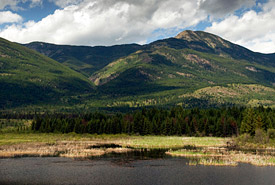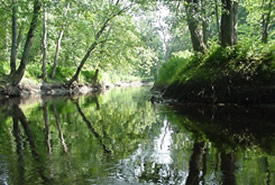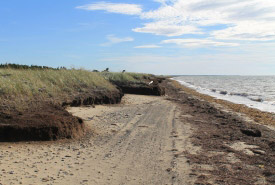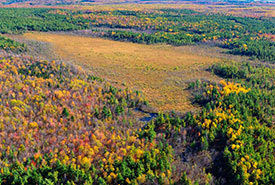Why Canada matters on World Wetlands Day

Wetlands in the Marion Creek Benchlands, British Columbia (Photo by Tim Ennis/NCC)
While other nations have picked wetland wildlife, such as Finland’s whooper swan or Pakistan’s Indus crocodile, to represent their country, Canada is the only country in the world that has selected a wetland engineer as its national animal. By damming small creeks and streams, Canada’s five to 10-million-plus beavers build and maintain millions of acres of shallow ponds across our country. Shallow ponds and beaver meadows are not just good for beavers, but provide important habitat for other species ranging from moose to wood ducks.
Beaver-built wetlands, combined with vast swamps, fens, marshes and bogs, cover about 13 per cent of Canada. More importantly, the wetlands of the Great White North make up approximately one-quarter of all the wetlands left in the world. These wetlands are not just important for Canadians and our wildlife, but exert an ecological influence that has a global impact.
We have not been good stewards of our planet’s wetlands. Although they cover only about six per cent of the Earth’s surface, wetlands are one of the most impacted habitats. The global loss of wetlands is staggering. Since 1900, more than 64 per cent of the world’s wetlands have been lost, with about 50 per cent of this loss occurring since 1970.
While wetland losses in Asia and Europe have been especially high over the last generation, Canada’s wetlands have not been immune to extreme losses in some regions. Over 72 per cent of wetlands in southern Ontario and 50 per cent of Nova Scotia’s coastal salt marshes are now gone, and in British Columbia’s South Okanagan, only 15 per cent of the original wetlands remain.

Minesing Wetlands (Photo by Nottawasaga Valley Conservation Authority)
Canada has 37 wetlands that have been designated as Ramsar Wetlands of International Significance. These sites range from small, but important, wetland fragments in southern Canada, such as Minesing Wetlands in Ontario and Lac Saint-Pierre in Quebec, to vast wetlands in Canada’s boreal and Arctic, including Old Crow Flats in the Yukon and Rasmussen Lowlands in Nunavut. These sites cover just over one per cent of Canada, but represent some of our most important sites for protecting wetland habitats.
One of the significant features of wetlands is their biological productivity. Acre for acre, wetlands are some of the most productive ecosystems in the world, on par with tropical rainforests. Wetlands convert water, air and sunlight into an abundance of leaves, roots, insects and other wildlife — an abundance of life that reaches beyond just wetlands and influences the biology of surrounding forests, grasslands and cities.

Miscou Island Nature Reserve, NB (Photo by NCC)
The abundance of life that wetlands create benefits many species. In particular, many species of birds have come to rely on wetlands as reliable places to feed and raise their young. Many of Canada’s Important Bird Areas (IBAs) occur in wetlands, including IBAs that are significant from a global and continental perspective because they provide critical feeding and nesting habitat for birds that migrate to Canada every spring. These IBAs include sites such as Oak and Plum Lakes in Manitoba and Miscou Island in New Brunswick. Millions of ducks, geese, herons, shorebirds and songbirds that winter in the U.S. and beyond rely on these Canadian wetlands to raise the next generation.
Despite their importance for conservation, wetlands are generally under-represented in our national and provincial networks of parks and protected areas. In some regions of Canada, such as BC and Newfoundland and Labrador, only about 5 per cent of all wetlands are protected.
Canada has a goal of protecting at least 17 per cent of our lands and inland waters. But to meet this goal, these protected areas must be ecologically representative, and capture the habitat diversity of Canada. We need to ensure that wetlands are better represented in the places we protect in the future.
Wetlands also deliver a one-two punch in our fight against climate change. Some of the observed impacts of climate change include an increase in extreme storm events and flooding. The 100-year storm event our grandparents witnessed is now the 10-year storm event for our children. Wetlands act as a giant green paper towel on the landscape that absorb flood waters that spill from rivers and creeks. In addition to holding back these waters, they provide the additional service of removing sediments and pollution. Many cities and towns across Canada recognize that wetlands are an essential part of their municipal infrastructure in our new climate normal.

Covey Hill peatland (Photo by Mark Tomalty)
Wetlands are one of the planet’s original carbon storage technologies. Wetlands, particularly peatlands (often called muskeg in Canada), are a powerhouse when it comes to carbon storage. Peatlands cover only three per cent of the Earth’s land surface, but store more carbon than all of the world’s forests combined. It’s been estimated that a Canadian muskeg holds approximately 147 gigatons of carbon; the equivalent of one-fifth of all the carbon in the atmosphere today. Peatlands are one of the largest national storehouses of land carbon in the world. If we opened this carbon vault and released it, there would be major consequences to the world’s carbon budget and it would magnify the impacts of climate change to nature and to people across the planet.
Wetlands are places of immense biological importance that also support our economy and well-being. From providing habitat for rare species, to filtering our drinking water, wetlands matter to nature and Canadians. From producing ducks and geese that stretch across the autumn sky on their journey south, to playing a major role in the global carbon cycle, Canada’s wetlands matter to the planet. We have an obligation to Canadians and to the world to ensure their protection.



